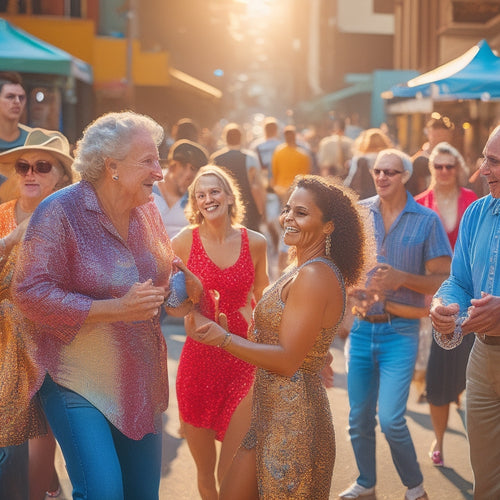Eating Disorder Awareness Through Dance Guide
Share
Dance, a celebration of the human body, often disguises a sinister reality: eating disorders that can ravage the very individuals who bring it to life. The pressure to conform to unrealistic beauty standards can lead to a silent struggle with eating disorders, masked by the pursuit of perfection. By embracing body positivity, dancers can break free from these harmful ideologies and tap into their full artistic potential. Cultivating a culture of self-care and body positivity is essential in promoting self-worth and reducing susceptibility to eating disorders. As we explore this complex issue further, we uncover the empowering strategies that can transform the dance community for the better.
Key Takeaways
• Dance culture prioritizes physical appearance over mental health, making it crucial to address eating disorders and promote body positivity.
• Unrealistic beauty standards in dance can lead to body dissatisfaction, increasing the risk of eating disorders among dancers.
• Embracing body positivity helps dancers focus on self-love and acceptance, rather than unattainable ideals, to cultivate a healthier relationship with their bodies.
• Awareness and education are essential in empowering dancers to recognize and resist the influence of eating disorders, promoting self-worth and self-care.
• By appreciating their bodies for strength, flexibility, and expressive capabilities, dancers can reduce their susceptibility to harmful ideologies leading to eating disorders.
Understanding Eating Disorders in Dance
In the world of dance, where physical beauty and technical precision are paramount, the pressure to conform to unrealistic standards can lead to a silent struggle with eating disorders, often masked by the very same pursuit of perfection that drives dancers to excel.
The dance community often prioritizes physical appearance over mental health, inadvertently perpetuating a culture of body dissatisfaction. This can lead to a heightened risk of eating disorders, which can have devastating consequences on a dancer's mental and physical well-being.
It is essential for dance educators, parents, and dancers themselves to recognize the warning signs of eating disorders and foster an environment that promotes positive body image and mental health awareness. By doing so, we can create a safer, more supportive dance community that values overall wellness.
The Importance of Body Positivity
By embracing body positivity, dancers can break free from the suffocating grip of unrealistic beauty standards, cultivating a healthier relationship with their bodies and tapping into their full artistic potential. This shift in mindset allows dancers to focus on self-love and acceptance, rather than aiming for an unattainable ideal.
| Negative Self-Talk | Body Positivity |
|---|---|
| 'I'm not thin enough' | 'I am worthy of love and respect, regardless of my shape' |
| 'I'll never be good enough' | 'I am capable and strong, and my body is capable too' |
| 'I hate my body' | 'I appreciate my body for all it can do' |
Empowering Dancers Through Awareness
As dancers cultivate a positive body image, they become more receptive to the empowering knowledge that can help them recognize and resist the insidious influence of eating disorders.
By fostering a culture of self-care and body positivity, dancers can develop a stronger sense of self-worth, untethered from the unrealistic beauty standards that often perpetuate disordered eating behaviors.
As they learn to appreciate their bodies for their strength, flexibility, and expressive capabilities, they become less susceptible to the harmful ideologies that can lead to eating disorders.
Frequently Asked Questions
How Can Dance Teachers Identify Early Signs of Eating Disorders in Students?
Dance teachers can identify early signs of eating disorders in students by conducting regular risk assessments, participating in teacher training, fostering body awareness, respecting student privacy, and cultivating a safe and supportive classroom culture.
Can Eating Disorders Affect Dancers of All Body Types and Ages?
Delicately shattering the myth that eating disorders only affect a specific body type or age group, vulnerability factors and ageism stigma can affect dancers of all shapes, sizes, and ages, making awareness and education vital for early intervention and support.
Are There Any Specific Dance Styles More Prone to Eating Disorders?
Certain dance styles, such as ballet and contemporary, may be more prone to eating disorders due to intense body scrutiny and genre pressure to conform to aesthetic ideals, increasing vulnerability to disordered eating and body dissatisfaction.
How Can Parents Support Dancers Struggling With Body Image Issues?
"Ironically, parents often unintentionally perpetuate body dissatisfaction; instead, they can support dancers by fostering open communication, providing positive reinforcement, promoting media literacy, and introducing healthy role models, thereby cultivating a safe and empowering environment."
Are There Any Legal Responsibilities for Dance Studios Regarding Eating Disorders?
Dance studios have a moral and potential legal obligation to prioritize dancer wellness, considering liability waivers and implementing thorough studio policies that address eating disorders, ensuring a safe and supportive environment for all dancers.
Related Posts
-

Video Courses to Perfect Dance Makeup Skills Online
You can now refine your dance makeup skills with online video courses that cater specifically to the unique demands o...
-

5 Best Free YouTube Dance Makeup Tutorials
You're ready to elevate your dance performances with stunning makeup looks, and we're here to help! Our top 5 free Yo...
-

Sydney Street Dance Study Sparks Community Revival
In Sydney, a thriving street dance scene has revitalized the city's parks, streets, and studios, fostering a profound...


